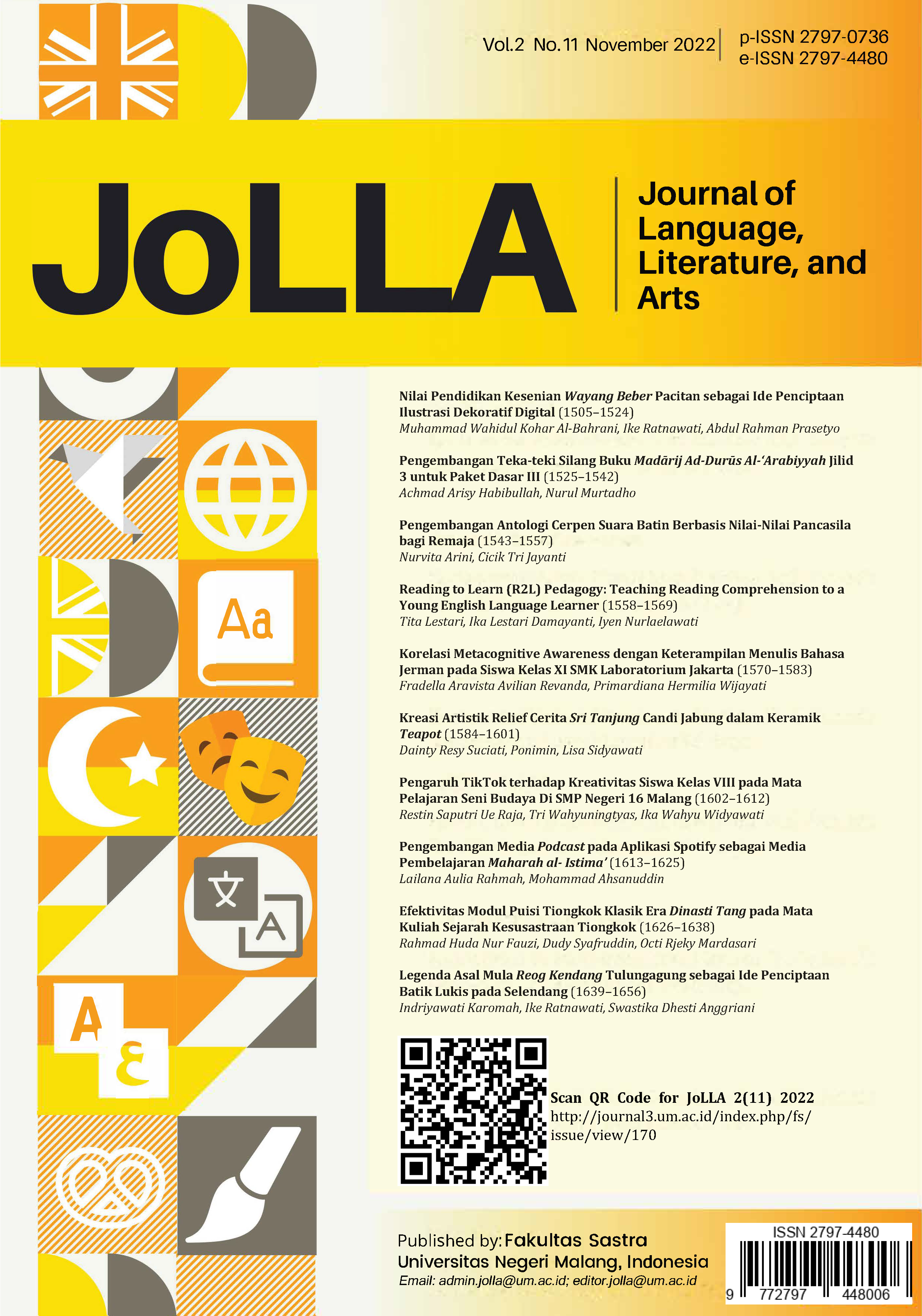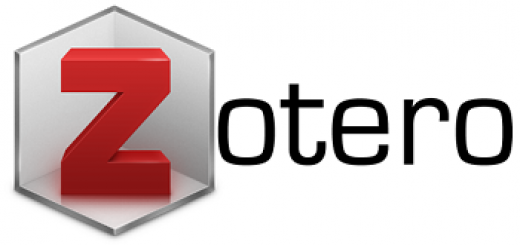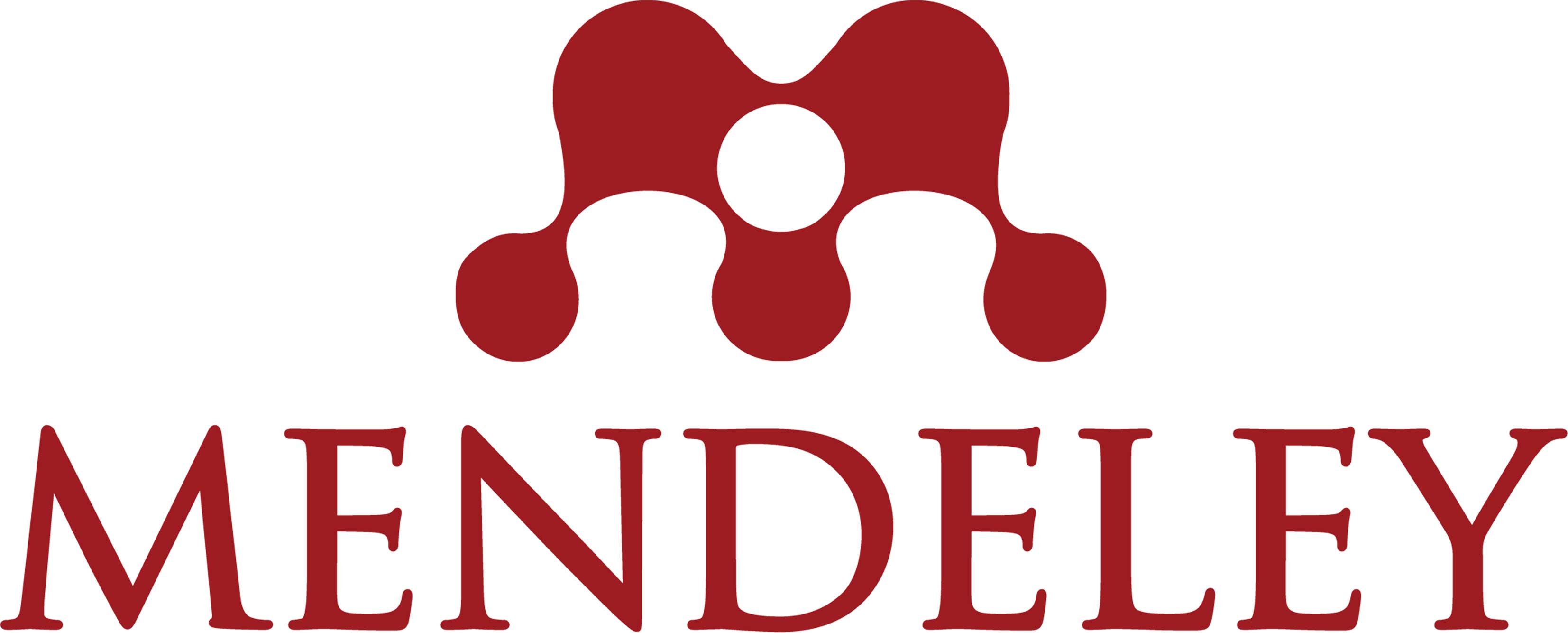Reading to Learn (R2L) Pedagogy: Teaching Reading Comprehension to a Young English Language Learner
DOI:
https://doi.org/10.17977/um064v2i112022p1558-1569Keywords:
EFL classroom, Kurikulum Merdeka, Reading to Learn (R2L) pedagogy, Reading comprehension, Young learnerAbstract
Abstract: Reading to Learn (R2L) pedagogy is a child-friendly approach that aims to minimize the literacy gap among learners. R2L pedagogy is applicable at every level of education with the use of various text types. Considering many significant aspects of R2L, this approach could be used in Indonesia to help learners fulfilling the high demand of Kurikulum Merdeka at primary and junior high school levels. However, only little research using R2L pedagogy in Indonesian primary school contexts was found. Therefore, this research is intended to discover how R2L pedagogy supports a young English language learners’ reading comprehension. Using a case study methodology, the researcher implemented to activities, namely (1) preparing for reading and (2) detailed reading phase adapted from Rose and Martin (2012). Moreover, the researcher used videotapes observation and the learners’ sample works in collecting the data. In analyzing the data, the researcher used thematic analysis by Creswell and Creswell (2018) and categorized the data into selected codes and themes which is expected to show how R2L pedagogy supports a young English language learners’ reading comprehension.
Keywords: EFL classroom; Kurikulum Merdeka; Reading to Learn (R2L) pedagogy; reading comprehension; young learners
Abstrak: Reading to Learn (R2L) adalah pendekatan pedagogi ramah anak yang bertujuan untuk meminimalisir kesenjangan literasi antar peserta didik. Pendekatan pedagogi R2L dapat diterapkan di setiap jenjang pendidikan dengan penggunaan berbagai jenis teks. Mengingat banyak aspek penting dari R2L, pendekatan ini dapat digunakan di Indonesia untuk membantu siswa memenuhi tuntutan Kurikulum Merdeka yang tinggi di jenjang Sekolah Dasar dan Sekolah Menengah Pertama. Namun, penelitian yang menggunakan pendekatan pedagogi R2L di sekolah dasar, khususnya di Indonesia, masih sedikit ditemukan. Oleh karena itu, penelitian ini dimaksudkan untuk mengetahui bagaimana pendekatan pedagogi R2L mendukung pemahaman membaca pembelajar bahasa Inggris usia dini. Dengan menggunakan metodologi studi kasus, peneliti menerapkan dua kegiatan, yaitu (1) preparing for reading dan (2) detailed reading yang diadaptasi dari Rose dan Martin (2012). Selain itu, peneliti menggunakan observasi kelas dan contoh karya siswa dalam mengumpulkan data. Dalam menganalisis data, peneliti menggunakan analisis tematik oleh Creswell dan Creswell (2018) dan mengkategorikan data ke dalam kode dan tema terpilih yang diharapkan dapat menunjukkan bagaimana pendekatan pedagogi R2L mendukung pemahaman membaca pembelajar bahasa Inggris usia dini.
Kata kunci: EFL classroom; Kurikulum Medeka; Reading to Learn (R2L) pedagogy; pemahaman membaca; pembelajar usia dini
References
Academic English UK. (2022). Academic reading. Retrieved from https://academic-englishuk.com/reading-skills/
Aditomo, A. (Ed.) (2021). Kajian akademik: Kurikulum untuk pemulihan pembelajaran. Jakarta: Kementerian Pendidikan, Kebudayaan, Riset, dan Teknologi. Retrieved from https://ditpsd.kemdikbud.go.id/upload/filemanager/download/kurikulum-merdeka/Kajian%20Akademik%20Kurikulum%20untuk%20Pemulihan%20Pembelajaran%20(2).pdf
Angraini, W., & Rozimela, Y. (2020). The implementation genre-based approach in teaching reading at sen-ior high school. Proceedings of the Eighth International Conference on Languages and Arts (ICLA 2019). doi: https://dx.doi.org/10.2991/assehr.k.200819.020
Ariyanfar, S., & Mitchell, R. (2020). Teaching writing skills through genre: Applying the genre-based ap-proach in Iran. International Research Journal of Management, IT, & Social Sciences, 7(1), 242–257. doi: https://doi.org/10.21744/irjmis.v7n1.843
Becerra, T., Herazo, J., Garcia, P., Sagre, A., & Diaz, L. (2020). Using reading to learn for EFL students’ read-ing of explanations. ELT Journal, 73(3), 237–246. doi:10.1093/elt/ccz053
Bogale, Y. N. (2018). Conceptualizing reading to learn: Strategy instruction and EFL students’ reading com-prehension. International Journal of Curriculum and Instruction, 10(2), 93–117. Retrieved from https://www.semanticscholar.org/paper/Conceptualizing-Reading-to-Learn%3A-Strategy-and-EFL-Bogale/b973bad8ac433c8d7f10ca6bcc840e2ea94884be
Chien, C.-W. (2013). Using Raphael’s QARs as differentiated instruction with picture books. English Teacher Forum, 51(3), 20–27. Retrieved from https://files.eric.ed.gov/fulltext/EJ1020728.pdf
Creswell, J. W. (2003). Research design: Qualitative, quantitative, and mixed methods approaches. London: SAGE Publications.
Creswell, J. W., & Creswell, J. D. (2018). Research design: Qualitative, quantitative, and mixed methods ap-proaches (5th ed.). London: SAGE Publications.
Creswell, J. W., & Poth, C. N. (2018). Qualitative inquiry and research design: Choosing among five approaches (C. N. Poth, Ed.). London: SAGE Publications.
Damayanti, I. L. (2017). From storytelling to story writing: The implementation of Reading to Learn (R2L) pedagogy to teach English as a foreign language in Indonesia. Indonesian Journal of Applied Linguistics, 6(2), 229–242. doi: dx.doi.org/10.17509/ijal.v6i2.4870
Daniarti, Y., Taufiq, R., & Sunaryo, B. (2020). The implementation of teaching reading through genre based approach for university students. Journal of Physics: Conference Series, 1477. doi: 10.1088/1742-6596/1477/4/042064
Grand Canyon University. (2020). Why is reading important? 11 positive impacts of reading. Retrieved from https://www.gcu.edu/blog/teaching-school-administration/importance-and-impact-of-reading
Hamra, A., & Syatriana, E. (2010, February). Developing a model of teaching reading comprehension for EFL students. TEFLIN Journal, 21(1), 27–40. doi: http://dx.doi.org/10.15639/teflinjournal.v21i1/27-40
Kendeou, P., van den Broek, P., Helder, A., & Karlsson, J. (2014). A cognitive view of reading comprehen-sion: Implications for reading difficulties. Learning Disabilities Research & Practice, 29(1), 10–16. doi: https://doi.org/10.1111/ldrp.12025
Kepala Balitbang dan Perbukuan. (2021). Keputusan kepala badan penelitian dan pengembangan dan per-bukuan nomor 28 tentang capaian pembelajaran paud, SD, SMP, SMA, SLDB, SMPLB, dan SMALB pada program sekolah penggerak. Retrieved from https://penggerak-simpkb.s3.ap-southeast-1.amazonaws.com/portal-programsekolahpenggerak/wp-content/uploads/2021/09/14081555/SALINAN_SURAT-KEPUTUSAN-NOMOR-028-CP-PAUD-SD-SMP-SMA-SDLB-SMPLB-DAN-SMALB.pdf
Mataka, T. W., Mukurunge, T., & Bhila, T. (2020, June). Reading to Learn (RTL) through story books: Mov-ing beyond physical school access to epistemological access in a grade R classroom in the Eastern Cape, South Africa. International Journal of All Research Writings, 1(12), 26–35. Retrieved from http://www.ijarw.com/Users/ManuScript/PastIssueDetails/b8cc4a1b-c332-4a37-98be-44d163316fd4#
Mauludin, L. A. (2020). Joint construction in genre-based writing for students with higher and lower moti-vation. Southern African Linguistics and Applied Language Studies, 38(1), 46–59. doi: https://doi.org/10.2989/16073614.2020.1750965
Menco-Haeckermann, V. (2020). From curriculum demands to genre pedagogy: Bilingual adaptation of reading to learn for an L2 lesson planning. Signo, 46(86), 147–163. doi: https://doi.org/10.17058/signo.v46i86.16522
Mih, V., & Mih, C. (2008). The construction of mental representations during reading: Inferences genera-tion. Neue Didaktik, 1, 41–51. doi: https://doi.org/10.25656/01:7328
Millin, T., & Millin, M. (2018). English academic writing convergence for academically weaker senior sec-ondary school students: Possibility or pipedream?. Journal of English for Academic Purposes, 31, 1–17. doi: https://doi.org/10.1016/j.jeap.2017.12.002
Millin, T., Millin, M., & Pearce, J. (2020). Unpacking the efficacy of Reading to Learn using cognitive load theory. Journal of Academic Language & Learning, 14(1), 113–126. Retrieved from https://hdl.handle.net/10092/101619
Montero-Arévalo, S. J. (2019). Effects Of Genre Based Approach (GBA) in EFL reading comprehension and writing. GIST – Education and Learning Research Journal, 19, 84–100. Retrieved from https://eric.ed.gov/?id=EJ1237432
Muhassin, M., Annisa, J., & Hidayati, D. A. (2021). The impact of fix up strategy on Indonesian EFL learn-ers’ reading comprehension. International Journal of Instruction, 14(2), 253–270. doi: http://dx.doi.org/10.29333/iji.2021.14215a
Nanda, D. W., & Azmi, K. (2020). Poor reading comprehension issue in EFL classroom among Indonesian secondary school students: Scrutinizing the causes, impacts and possible solutions. Journal of Lan-guage, Education, and Humanities, 8(1), 12–24. doi: 10.22373/ej.v8i1.6771
Nation, K. (2005). Children's reading comprehension difficulties. In M. J. Snowling & C. Hulme (Eds.), The science of reading: A handbook (pp. 248–265). Oxford: Blackwell Publishing. doi: https://doi.org/10.1002/9780470757642.ch14
NSW Government. (2021). Literal comprehension. Retrieved from https://education.nsw.gov.au/teaching-and-learning/student-assessment/smart-teaching-strategies/literacy/reading/literal-comprehension
Pham, V. P. H., & Bui, T. K. L. (2021). Genre-based approach to writing in EFL contexts. World Journal of English Language, 11(2), 95–106. doi: https://doi.org/10.5430/wjel.v11n2p95
Phichiensathien, P. (2018). Genre-based approach in academic English writing. Teaching English as EFL 2018.
Raphael, T. E., & Au, K. H. (2011). QAR: Enhancing comprehension and test taking across grades and con-tent areas. The Reading Teacher, 59(3), 206–221. doi: https://doi.org/10.1598/RT.59.3.1
Rizqon, M. K., Andreani, S., & Astuti, U. P. (2021). The problems faced by senior high school students in reading narrative text. JoLLA: Journal of Language, Literature, and Arts, 1(11), 1508–1522. doi: 10.17977/um064v1i112021p1508-1522
Rombot, O., Boeriswati, E., & Suparman, M. A. (2020). Improving reading comprehension skills of interna-tional elementary school students through blended learning. Al Ibtida: Jurnal Pendidikan Guru MI, 7(1), 56–68. doi: 10.24235/al.ibtida.snj.v7i1.6045
Rose, D. (2017). Languages of Schooling: Embedding literacy learning with genre-based pedagogy. Europe-an Journal of Applied Linguistics, 5(2), 1–31. doi: https://doi.org/10.1515/eujal-2017-0008
Rose, D., & Martin, J. (2012). Learning to write, reading to learn. Sheffield: Equinox Publishing.
Rose, D., & Martin, J. (2019). Preparing for reading and writing (Book 1 of Reading to learn Teachers Re-source Book Package). Australia: Reading to Learn.
Shum, M., Gao, F., & Ki, W. W. (2016). School desegregation in Hong Kong: Non-Chinese linguisticminority students’ challenges to learning Chinese in mainstream schools. Asia Pacific Journal of Education, 36(4), 533–544. doi: https://doi.org/10.1080/02188791.2015.1005048
Stoller, F. L., & Grabe, W. (2011). Teaching and researching reading (2nd ed.). London: Longman/Pearson.
Sunggingwati, D., & Nguyen, H. T. M. (2013). Teachers’ questioning in reading lessons: A case study in In-donesia. Electronic Journal of Foreign Language Teaching, 10(1), 80–95. Retrieved from https://e-flt.nus.edu.sg/wp-content/uploads/2020/09/v10n12013/sunggingwati.pdf
Suryanto. (2017). An investigation on English reading comprehension problems in Indonesian cultural contexts. Proceedings of The 1st International Conference on Education, Science, Art and Technology (ICESAT). Retrieved from https://ojs.unm.ac.id/icesat/article/view/3738
Think Student. (2022). Why is reading important for students?. Retrieved from https://thinkstudent.co.uk/why-is-reading-important-for-students/
United Nations. (n.d.). The 17 goals | Sustainable development goals. Retrieved June 16, 2022, from https://sdgs.un.org/goals
Vencesla, J. G. (2021). Applying the reading to learn pedagogy to improve entrepreneurship students’ ex-position texts. A Journal on Applied Linguistics and Langauge Education, 9(1). 37–48. doi: https://doi.org/10.33508/bw.v9i1.2808
Yamac, A., & Ulusoy, M. (2016). The effect of digital storytelling in improving the third graders’ writing skills. International Electronic Journal of Elementary Education 9(1), 59–86. Retrieved from https://dshutkin386.files.wordpress.com/2019/01/yamac%CC%A72016digitalstorytellingthirdgraderswriting.pdf
Yin, R. K. (2018). Case study research and applications: Design and methods. London: SAGE Publications.
Downloads
Published
How to Cite
Issue
Section
License
Copyright (c) 2022 Tita Lestari, Ika Lestari Damayanti, Iyen Nurlaelawati

This work is licensed under a Creative Commons Attribution-ShareAlike 4.0 International License.





























